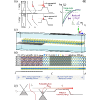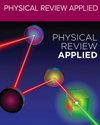Electron-phonon scattering in two-dimensional Dirac-source transistors
IF 4.4
2区 物理与天体物理
Q2 PHYSICS, APPLIED
引用次数: 0
Abstract
Electron-phonon (-ph) scattering is a key effect in quantum transport and electronic device physics which is, however, often neglected in atomistic device simulation due to its impractical computational burden. Here we investigate e-ph effects in two-dimensional (2D) FETs, where the injecting source is graphene that inject “Dirac” electrons into the FET channel. Such a Dirac-source FET was experimentally known to have excellent transfer characteristics for its lower off-state current due to the electronic structure of the graphene. By using an approximate but computationally efficient technique (the Zacharias-Giustino method) to capture e-ph scattering, we quantitatively analyze to what extent e-ph scattering affects the operation of Dirac source, as a function of temperature. Our nonequilibrium Green’s function density-functional-theory analysis microscopically reveal the e-ph scattering and we make a comprehensive evaluation of it across real, momentum, and energy spaces, covering both the tunneling and thermionic emission regions. The findings suggest that e-ph scattering does not significantly impact the overall performance of the Dirac-source FETs. For the graphene- device, the e-ph effects amount to somewhat increase the off-state current, which is not significant as to alter the subthreshold property of the transistor. Other factors, such as gate efficiency—determined by the body factor—exhibit a more pronounced influence on device performance for this system.

二维狄拉克源晶体管中的电子-声子散射
电子-声子(e-ph)散射是量子传输和电子器件物理中的一个关键效应,但由于其不切实际的计算负担,在原子器件模拟中经常被忽视。在这里,我们研究了二维(2D)场效应晶体管中的 e-ph 效应,其中的注入源是石墨烯,它能将 "狄拉克 "电子注入场效应晶体管通道。实验证明,由于石墨烯的电子结构,这种狄拉克源场效应晶体管具有出色的传输特性,离态电流较低。通过使用一种近似但计算效率高的技术(Zacharias-Giustino 方法)来捕捉电子相散射,我们定量分析了电子相散射在多大程度上影响了狄拉克源的运行,并将其作为温度的函数。我们的非平衡格林函数密度-函数理论分析从微观上揭示了电子ph散射,并在实空间、动量空间和能量空间对其进行了全面评估,涵盖了隧道发射和热离子发射区域。研究结果表明,e-ph 散射不会对狄拉克源场效应晶体管的整体性能产生重大影响。对于石墨烯-WSe2 器件,e-ph 效应在一定程度上增加了关态电流,但这并不会显著改变晶体管的亚阈值特性。其他因素,如由体因子决定的栅极效率,对该系统器件性能的影响更为明显。
本文章由计算机程序翻译,如有差异,请以英文原文为准。
求助全文
约1分钟内获得全文
求助全文
来源期刊

Physical Review Applied
PHYSICS, APPLIED-
CiteScore
7.80
自引率
8.70%
发文量
760
审稿时长
2.5 months
期刊介绍:
Physical Review Applied (PRApplied) publishes high-quality papers that bridge the gap between engineering and physics, and between current and future technologies. PRApplied welcomes papers from both the engineering and physics communities, in academia and industry.
PRApplied focuses on topics including:
Biophysics, bioelectronics, and biomedical engineering,
Device physics,
Electronics,
Technology to harvest, store, and transmit energy, focusing on renewable energy technologies,
Geophysics and space science,
Industrial physics,
Magnetism and spintronics,
Metamaterials,
Microfluidics,
Nonlinear dynamics and pattern formation in natural or manufactured systems,
Nanoscience and nanotechnology,
Optics, optoelectronics, photonics, and photonic devices,
Quantum information processing, both algorithms and hardware,
Soft matter physics, including granular and complex fluids and active matter.
 求助内容:
求助内容: 应助结果提醒方式:
应助结果提醒方式:


